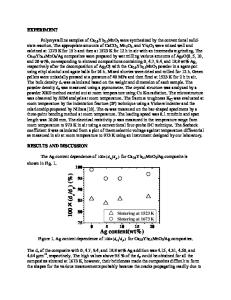High-temperature Thermoelectric Properties of the Ca 1-x Bi x MnO 3 System
- PDF / 133,641 Bytes
- 4 Pages / 612 x 792 pts (letter) Page_size
- 48 Downloads / 399 Views
Polycrystalline samples of Ca1−xBixMnO3 (0.02 艋 x 艋 0.20) were studied by means of x-ray diffraction, electrical resistivity (), thermoelectric power (S), and thermal conductivity () at high temperature. Bi doping leads to the lattice parameters a, b, and c increasing. And the and the absolute value of S decrease rapidly with Bi doping. The largest power factor, S2/, is obtained in the x ⳱ 0.04 sample, which is 3.6 × 10−4 W m−1 K−2 at 400 K. The figures of merit (Z ⳱ S2/) for this sample and 1.0 × 10−4 and 0.86 × 10−4 K−1 at 600 and 1000 K, respectively. I. INTRODUCTION
Thermoelectrics, namely energy conversion between heat and electricity via thermoelectric phenomena in solids, has long been a fundamental issue in condensed matter physics and is currently attracting a renewed interest as a promising energy-conversion technology that is not harmful to the environment. Performance of thermoelectric (TE) materials can be evaluated by a figure of merit defined as Z ⳱ S2/ (or ZT ⳱ S2T/; T, temperature), where S, , and are the Seebeck coefficient, electrical resistivity, and thermal conductivity, respectively. In comparison with conventional TE materials such as metal chalcogenides,1,2 transition metal disilicides,3–5 and Si–Ge alloys,6–8 metal oxides, due to their high thermal and chemical stability, have attracted more and more attentions. Among the oxide TE materials, cobalt oxides with layered structure [such as NaCo2O4 (Co-124), Ca3Co4O9 (Co-349), and Bi2Sr2Co2Oy (BC-222)] have been found to be strong p-type candidates.9–13 For n-type TE materials, some candidates, including (ZnO)5In2O3, In2O3 ⭈ MO (M ⳱ Cr, Mn, Ni, Zn, Y, Nb, Sn), (Zn, Al)O, and (Ba, Sr)PbO3, have been systematically studied.14 –17 As a member of the large family of perovskitetype oxides, the electron-doped CaMnO3 system has also been suggested to be potential material for high-temperature thermoelectrics.18,19 Furthermore, the one oxide TE module had been fabricated using Ca0.92La0.08MnO3 n-type legs and Ca2.75Gd0.25Co4O9 ptype legs by our group20 and has been proved to be operable for a few weeks in air showing high durability. However, for the electron-doped CaMnO3 system, only a few systematical studies about carrier concentration dependence of high-temperature TE properties were reported.21 Since the parameters S, , and are dependent a)
Address all correspondence to this author. e-mail: [email protected]
1092
http://journals.cambridge.org
J. Mater. Res., Vol. 17, No. 5, May 2002 Downloaded: 18 Mar 2015
on each other, optimization of the TE performance always requires a compromise between them. The adjustment of carrier concentration by doping is a feasible route to optimizing the TE performance. Our experimental results indicate that the highest power factor (PF), S2/, and the figure of merit, Z, were reached at an optimal carrier density near x ⳱ 0.04 for Ca1−x Mx MnO3 (M: Bi3+, La3+, etc.).22 And also the Bi-doped CaMnO3 system was found to show the best TE performance among these systems. In this paper, a series o
Data Loading...










